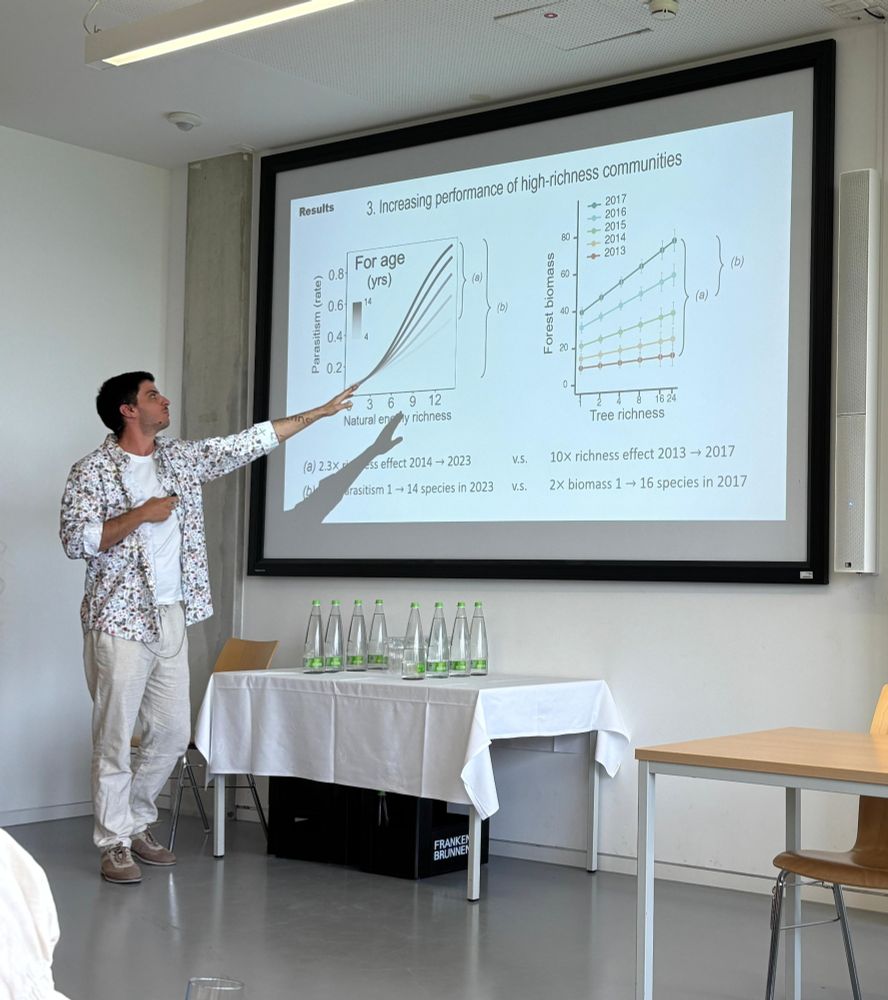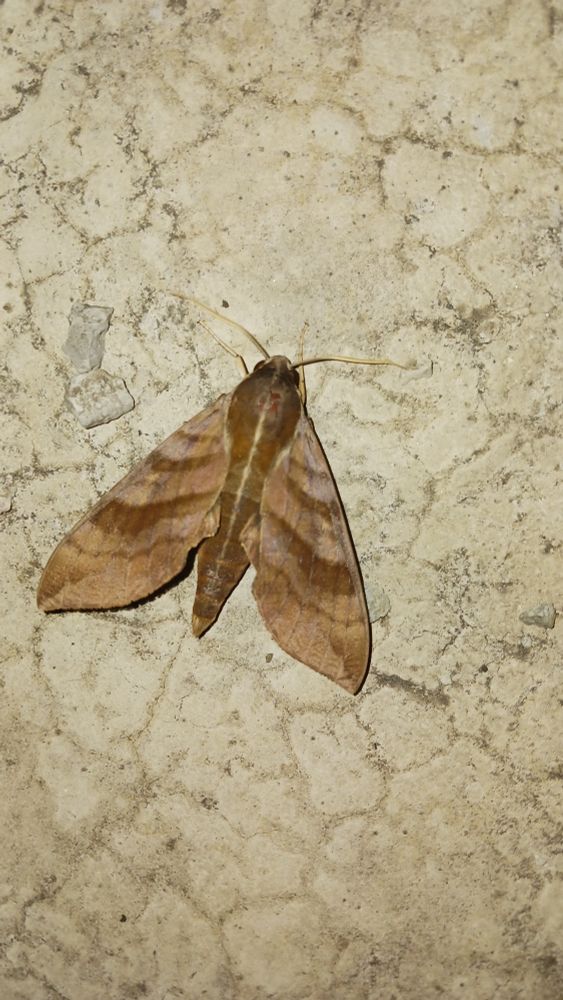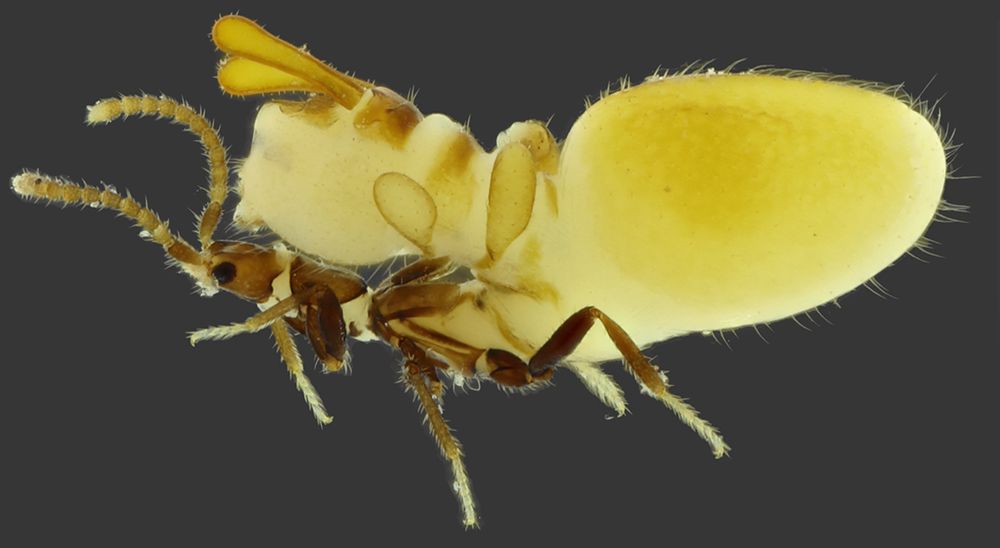
Our new @nature.com shows that energy flows mediated by mammals and birds across sub-Saharan Africa have declined by >30% unevenly across functional groups, with major consequences ecosystem functions
shorturl.at/AD0Yb
@entomassi.bsky.social
Entomologist | PhD @ Uni Freiburg 🐝 Insect ecology & multitrophic interactions 🌿 Food web dynamics in growing forests 📸 Macrophotography

Our new @nature.com shows that energy flows mediated by mammals and birds across sub-Saharan Africa have declined by >30% unevenly across functional groups, with major consequences ecosystem functions
shorturl.at/AD0Yb

Check this out: the global biomass of mammals since 1850
just out in @natcomms.nature.com
www.nature.com/articles/s41...
🌐

text with a picuture of gabreil rabinovich saying "Gabriel Rabinovich, immunologist, tumor biologist, and glycobiologist Writing has played a key role in my career as a researcher. I firmly believe that one does not simply write up results sequentially; instead, one tells a story. I've always enjoyed storytelling. After completing the experiments, I try to craft a narrative that appeals to an interdisciplinary audience, not just to specialists in my field. My goal is always for people from other disciplines to be able to understand my papers. Writing in a linear, step-by-step way can feel monotonous and dull. I try to construct a compelling story. Sometimes, it's not the question I asked at the beginning, but the one that emerges from all the results taken together. This approach has had a big impact on how my papers are received. When editors read something that tackles a meaningful question in the field, they're more likely to be positive with it. That’s why I put a lot of effort into the cover letters. They’re the first thing editors see, and I structure them point-by-point with clear logic to show that the paper addresses an open question in the literature. "
“You don’t just write results, you tell a story”
Gaby Rabinovich reminds us to write for an interdisciplinary audience, be honest about limits, and keep the big question clear
Read more in A Pocket Guide to Scientific Writing & Publishing!
mybook.to/ScienceGuide 🧪🌐📖

What makes leaf litter attractive to decomposers? 🍂
As Christian Wirth noted at ARBOfun last week, nutrient resorption varies among tree species - leaving litter feeders with a diverse buffet to choose from. #TreeDi-MultiTroph conference #Ecology #SoilLife #Biodiversity
Joint conference between @treedi.bsky.social and @multitroph.bsky.social has begun in Leipzig! Good way to start my last year of PhD 🕷🐛🐝🌿
14.10.2025 11:20 — 👍 6 🔁 2 💬 0 📌 0
Scary title for sure.. questionable picture 🤔🐝
www.theguardian.com/environment/...

A sweat bee resting on a flower.
A new study in Science evaluating published data from 19 countries has pinpointed the minimum habitat levels needed to sustain pollinators in agricultural landscapes. https://scim.ag/3VIq4Cg
05.10.2025 20:01 — 👍 77 🔁 21 💬 2 📌 1
Syrphid fly pointing face first towards camera, big red eyes, perched on my finger

Syrphid fly perched on my finger, lateral view shows abdomen with its orange and black stripes resembling a bee
It's not only bees. Syrphid flies are also very important pollinators and are so gosh darn cute 😍
Episyrphus balteatus,☝️ for scale

📢Check out our latest BE-publication on #invertebrate 🐞abundance in #grasslands 🌱 published in @basicapplecol.bsky.social.
Reducing land use (single late #mowing) increased #insects by +41% after 1 yr and +99% after 3 yrs.
Species diversity, however, remained unchanged.
🔗 doi.org/10.1016/j.ba...

🗞️New study in @globalchangebio.bsky.social 🗞️
🌳Diversity in resource use strategies promotes productivity across a global network of tree #diversity experiments?🌲
Read our new study led by Joel Jensen together with #TreeDivNet here:
onlinelibrary.wiley.com/doi/10.1111/...

A white-fronted bee-eater (Merops bullockoides) decides whether to consume a warningly colored white-barred acraea butterfly (Telchinia encedon). Photo (c) Mike Rowe
📢🦋 Our paper ‘Global selection on insect antipredator coloration’ is out and featured on the cover of @science.org
We ran a huge experiment to find out how ecological context favours camouflage and warning colouration as antipredator strategies. 1/6
www.science.org/doi/10.1126/...

Our paper on species and trait abundance distributions in @jappliedecology.bsky.social is now out in an issue:
besjournals.onlinelibrary.wiley.com/doi/10.1111/...
Led by Werner Ulrich and many other great colleagues.



The german+austian+swiss conference of #ecology (gfö) just wrapped up, and I was stoked to present results from a long-term biodiversity study - a huge combined effort involving a decade of insect population monitoring.
I also managed to check out some entomological collections in Würzburg! 🐝

New Europe-wide study finds that efforts to provide pollinator habitat in urban areas - such as sowing wildflower mixes - really do work, boosting numbers of bees and butterflies: onlinelibrary.wiley.com/doi/10.1111/...
19.08.2025 09:51 — 👍 172 🔁 79 💬 3 📌 4

And that's #labwork also wrapped up! For the next year my PhD will exclusively exclusively involve writing manuscripts... I have mixed feelings about that 😅
This here is just a small part of the insects that we sampled. Some very cool bees and wasps, including potentially new species.

📢 ITV-net: the first Italian database on #PlantFunctionalTraits with #IntraspecificTraitVariability 🌱
ITV-net includes over 8,500 leaf trait records (LA/SLA) for 709 plant species across 8 Italian habitats, from coastal dunes to alpine grasslands.
#EnviXLab
www.tandfonline.com/doi/full/10....

Here is a picture from above, showing the skull on the thorax and the gorgeous wing pattern
24.07.2025 06:38 — 👍 5 🔁 0 💬 0 📌 0Ever seen a moth do some #pushups? 💪💪💪💪💪💪
This big guy came flying to our light trap! We handled him carefully and let him go shortly later. Here he's showing some defensive mechanism to scare us off.
Species: Greater death's head hawkmoth




Back in Jiangxi for one last PhD field trip. Couldn't help but immediately set up a light trap to see what's flying. Fingers crossed for some big beetles 🪲
20.07.2025 15:29 — 👍 1 🔁 0 💬 0 📌 0
In what may be one of Earth’s craziest forms of mimicry, researchers in 2023 reported a species of rove beetle that grows a termite puppet on its back to fool real termites into feeding it.
Learn more during #InsectWeek: scim.ag/40mj1S8
Every country is warming.
Every country is experiencing more extreme weather events because of climate change, mainly caused by burning fossil fuels. www.ShowYourStripes.info
Time to #ShowYourStripes and start climate conversations to prompt actions to reduce emissions, personally & collectively.

A black-striped orchard spider (Leucage celebesiana) waiting on a leaf for insect to fly into its web. Notice the single strand of silk holding the leaf in tension! Like so she'll be able to detect any minute vibration.
📍Dexing, Jiangxi China
#macromonday 🕸

Postdoc Job offer for Arthropod Ecologists 🪲🕷️
Michael Staab @leuphana.bsky.social offers a 3 year postdoc starting in October latest.
Arthropod diversity, interactions & functions in different research programs, e.g. @bexplo.bsky.social
Apply by June 19th
www.leuphana.de/en/universit...

Tiny grasshopper nymph, brown with some lighter coloured bands. Very tiny antennae a long face. Resting on a leaf, surrounded by blurred-out green
Hopping into #macromonday with this Monkey grasshopper nymph! Wishing all a good week filled with scientific reading and perhaps writing 📚🖋
Eumastacidae sp.

Our study ‘The #global #human impact on #biodiversity’ is out in @nature.com: www.nature.com/articles/s41...
🌍🌐🐟🌿🪲
Unprecedented synthesis of >2000 studies led by @francoiskeck.bsky.social shows humans are not only shrinking species numbers—but reshaping entire communities across the planet.
🧵1/5

Apple orchard with flowerstrip between rows of trees. Texts says "Would you by bee-friendly food?"
💬 Would you buy bee-friendly food? Then help us with your opinion and take part in our survey (approx. 20 min).
👉Your answers will help to make our food system more sustainable and promote the protection of pollinators.
Available in 7 different languages!
agreconlab.limesurvey.net/328536?lang=en
Great news today at Uni Freiburg! #FutureForests in coming to town 🌳🌳
23.05.2025 07:25 — 👍 1 🔁 0 💬 0 📌 0Holy smokes! I've got the male too! I'm tearing up. Just heard from the scientist that described the new species and this handsome lad is the male. So awesome!
(Chrysometa chuchaqui)

As described this 16” x 20” linocut print combines gold text in a central circle reading “OUR FATE” arching upwards, “IS TIED” horizontally across the middle, “TO THAT OF THE INSECTS” arching downwards in two lines with insects. Clockwise from top: two leaf cutter bees (Megachile relativa and M. brevis), the Imperial moth (Eacles imperialis), the Virgin Tiger moth (Apantesis virgo), an Isabella’s Longwings butterfly (Nymphalidae Eueides isabella), a blue orchard mason bee (Osmia lignaria), a firefly (Photinus pyralis), the rusty patched bumblebee (Bombus affinis), a white underwing moth (Catocala relicta), an eastern carpenter bee (Xylocopa virginica), a sweat bee (Agapostemon sericeus), a hummingbird clearwing moth (Hermaris thysbe), the common eastern bumblebee (B. impatiens), a long-horned bee (Melissodes sp.), a monarch butterfly (Danaus plexippus) and centre: eastern snail-shell nesting bee (O. conjuncta).
May 20 is World Bee Day. There are ~20,000 different bee species in the world. 🧪🧵🐝 Here in Ontario we have at least 400 native bees (none of which are honeybees, which are from Europe). Bees are key to pollination. According to the UN nearly 90% of the world’s wild flowering plant species depend, 🧵
20.05.2025 12:55 — 👍 391 🔁 181 💬 6 📌 3
A tiny bee of the genus Ceratina. Black, mostly hairless, with yellow legs and yellow thin horizontal stripes on the abdomen. Perched on a yellow flower with white petals (similar to a daisy).
Happy world #bee day!! Today we thank them for their hard work in supporting a key ecosystem function #pollination, and appreciate their beauty 🐝. Here, a Ceratina sp. on a flower in Jiangxi, China.
#macro